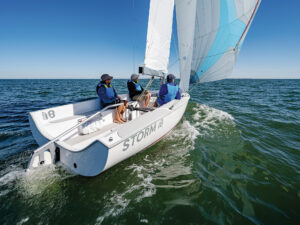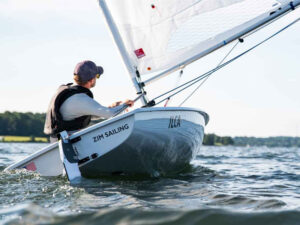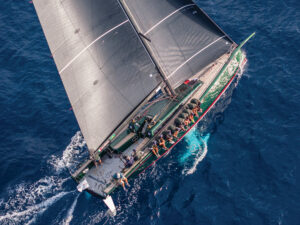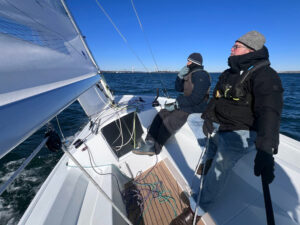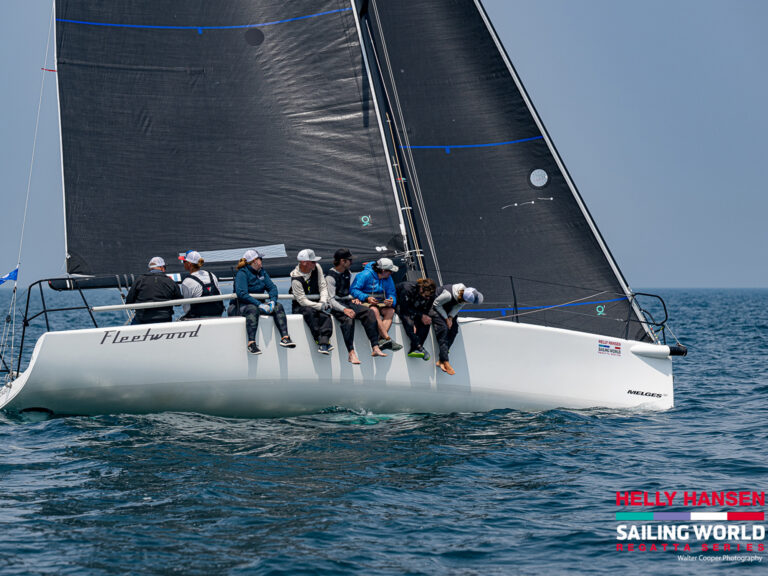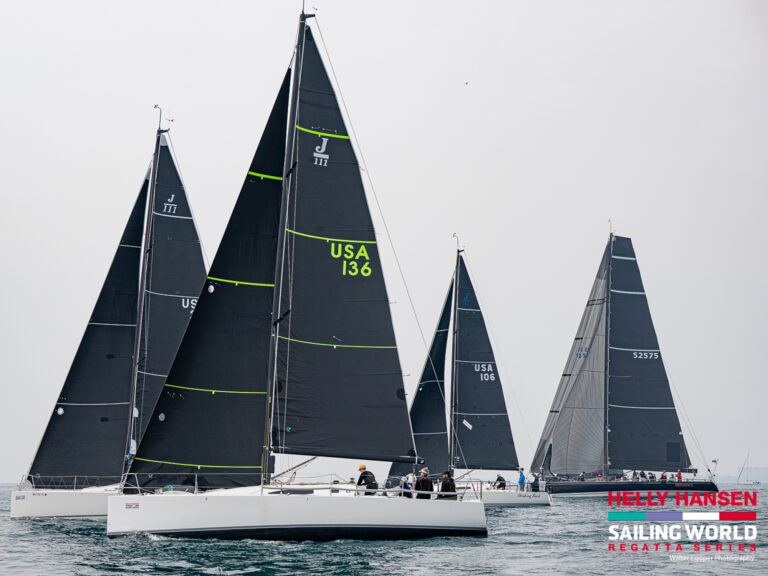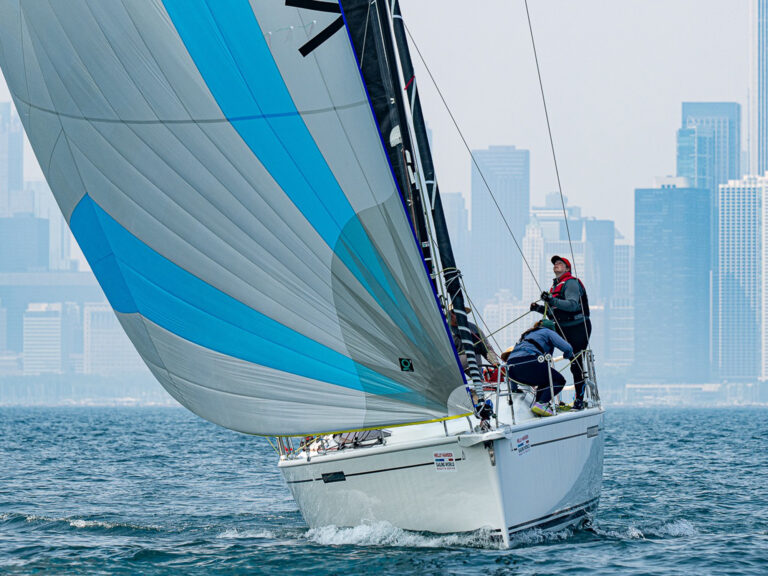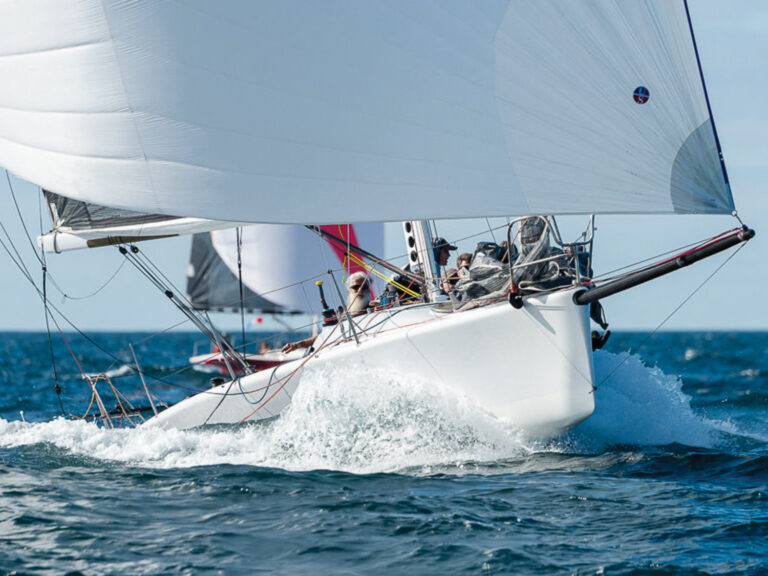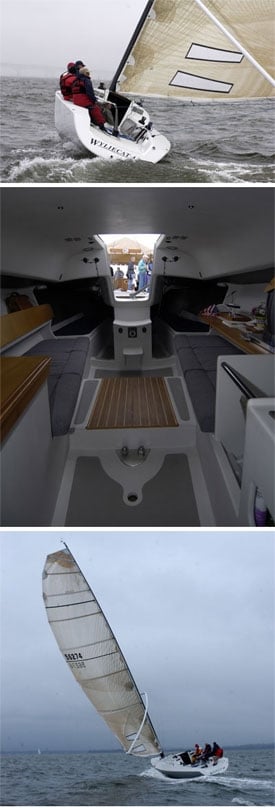
Wyliecat44
Wyliecat Yachts and Tom Wylie take many features used in other Wylie designs and combine them in a new way to make the Wyliecat 44 the most innovative boat of 2006. The bendy catboat rig with wishbone boom is used in the Wyliecat 30, 39, and 48 but here it is combined with the narrow hull reminiscent of the Wylie Wabbit [a 23-foot, 875-pound one-design boat that sails with a crew of three, one of them on a trapeze] and deep keel similar to the sloop-rigged Wylie-designed Open 60 Ocean Planet. This Wyliecat achieves much of its innovation through simplicity.Shorthanded sailing will be its forte; with only a huge mainsail, there’s one sail to trim-by the mainsheet, which is led to winches on each side of the cockpit. For singlehanding, it is within reach of the tiller, and if doublehanded, the trimmer sits just forward of the winch. There’s no traveler, so the mainsail leech tension is controlled upwind by the mainsheet and downwind by the wishbone-to-mast adjusting line, which is led to the cabin house. Of course, there are leech lines, cunninghams, and lazy jacks, but to get this boat sailing to its maximum potential, there are very few controls. Much like a windsurfer, the mast bends in the puffs and the sail flattens automatically. This depowering is important because the boat lacks the form stability of a wider boat. We sailed with four people on deck, usually three on the rail upwind, plus the helmsman. There wasn’t much for the rail riders to do other than for one to ease the main and then crank it back in. With the narrow beam, adding more people doesn’t add tremendously to this boat’s stability. During a tack there’s no jib sheet to grind, no jib to skirt, and no runners; just hike until the last second, take a short step or two across the boat and hike the other side. The hull-to-deck radius is well rounded and comfortable on the backs of the knees. Upwind our speeds were 7.7 to 8 knots by GPS in 16 to 20 knots of true wind speed. Estimating current effects, the “made good” tacking angles looked to be well inside 90 degrees.Off the wind this boat scooted right along, hitting 12 knots easily on the GPS. Bearing away from beating to downwind in a breeze does, like many modern racers, require easing the sheet to prevent the rudder from stalling. Most of us also experienced rudder stall when the boat was highly loaded on a reach, but easing the sheet, preventing any spinouts, quickly controlled this. Unfortunately, the optional spinnaker package was not available so we couldn’t see if the boat would really light up and plane. With just the main, downwind sailhandling required just the helm and a main trimmer to tail and release in the jibes. Simple, like a 44-foot Laser.The deck arrangement is simply clean. With just a tiller, the two mainsheet winches either side of the cockpit, a pair of winches on the cabin house, and a couple of hatches, there’s hardly a piece of excess hardware to be found. On our test boat, one of the mainsheet winches was electric and the main halyard could be led from the cabin top, down to the rail and then to this winch for easy hoisting. This powered winch was also great for sail trimming upwind as the winches were a little under-sized for our breezy day. Although no spinnaker gear was available, the test boat was rigged for a fractional spinnaker, which will be innovative in its own way. As a catboat, the mast is far forward so the low, mast-mounted spinnaker pole will protrude well forward of the stem. Afterguys lead around struts (which retract into the topsides) and then aft to cockpit winches. For jibes, both windward and leeward guys are set and then the asymmetric kite is jibed like a sprit boat. The system is similar to what’s used on several turbo-sleds, but without the complication of crossing the pole and the forestay. I think all the judges look forward to seeing this system prove itself on the racecourse.This boat is very light for 44 feet at 8,400 pounds, and it has 57 percent ballast, mostly in a lead bulb suspended 10 feet below the surface. Similar to Wylie’s Open 60, the deep fin that supports this ballast is hollow and welded from steel plate. It attaches to the hull with 12 high-strength keel bolts that are accessible between carbon beams and below a small section of cabin sole. With the boat’s light displacement and such high ballast percentage, there isn’t much left over for materials necessary to build the rest of the boat. To solve this puzzle, the hull and deck are built from carbon/vinylester laminates, each side of lightweight balsa SB50 core. Additionally, Wyliecat has pared the 44’s weight by reducing freeboard and beam; it’s one of the smallest 44-footers you’ll ever see. With a low deck and house, they’ve maintained adequate headroom below by eliminating the cabin sole (except over the keel frame). There’s non-skid finish directly on the inside of the hull skin. Structural bulkheads are foam cored and other interior panels are either foam cored or thin, lightweight plywood. For life aboard under way there are mesh-bottomed bunks port and starboard under the cockpit, settee berths amidships, and a small galley to port and chart table to starboard. Forward is an open head and platform for an in-port double berth where the feet split around the mast base. Keeping with the lightweight-and-simple theme, the engine is under the cockpit in a simple, non-insulated enclosure. While this is noisy under power, the installation is about as light as possible. Four screws remove each side panel, which then provides open access. The Yanmar 2 GM is the same engine seen in some 30-footers, but those boats weigh about the same and don’t have the benefit of a 40-foot waterline. Eliminating weight and lowering centers again, Wyliecat uses the keel fin for the diesel tank, much like an airplane’s wing tanks. Other systems are light and simple as well with two 12-volt gel-cell batteries, a 20-gallon water tank under a bunk, and a 6-gallon waste tank forward. The low overall weight is realized largely by the simplicity that runs throughout the Wyliecat 44 and is integral to its design. Less weight equates to less driving force necessary to push this boat to speed. Here the bendy rig, wishbone boom, simple sail control systems, and deep fin all combine to make a big boat that’s easy and efficient to sail shorthanded. Essentially, it’s a 44-foot Wylie Wabbit that could easily pass most other singlehanders on an afternoon day sail, or race for days with just two aboard. Although some other boats this size will have higher potential speed, it will be difficult for a shorthanded crew to keep them going as consistently fast as the Wyliecat 44. Wyliecat website.Alan Andrews is the owner and chief designer of Alan Andrews Yacht Design.

